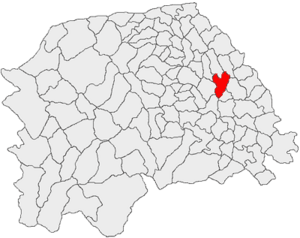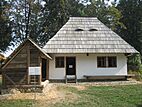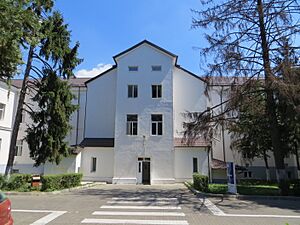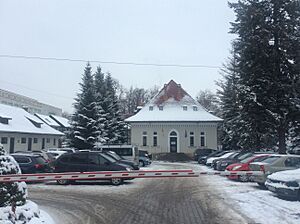Suceava facts for kids
Quick facts for kids
Suceava
Romanian: Suceava
Suczawa
|
||
|---|---|---|
       
Left to right: The Administrative Palace, The Justice Palace, Bukovina Museum, Suceava railway station (Burdujeni), Medieval Seat Fortress of Suceava, Ștefan cel Mare University of Suceava (USV), St. Apostoles Church in Ițcani, St. John of Nepomuk Church
|
||
|
||

Location in Suceava County
|
||
| Country | ||
| County | Suceava County | |
| Status | County seat | |
| Area | ||
| • Municipiu | 52.10 km2 (20.12 sq mi) | |
| • Metro | 473.29 km2 (182.74 sq mi) | |
| Population
(2022)
|
||
| • Municipiu | 84,308 | |
| • Density | 1,618.20/km2 (4,191.1/sq mi) | |
| Romanian ethnic majority with a few smaller minority groups | ||
| Demonym(s) | sucevean, suceveancă (ro) | |
| Time zone | UTC+2 (EET) | |
| • Summer (DST) | UTC+3 (EEST) | |
| Climate | Dfb | |
| Website | Primăria Suceava (ro, en) | |
Suceava is an important city in northeastern Romania. It is the main town of Suceava County. The city is located where Central Europe meets Eastern Europe.
Suceava is known for its rich history. It was once the capital of the Principality of Moldavia. This was a powerful kingdom in the Middle Ages. Today, you can visit its amazing medieval fortress. This fortress has been rebuilt and looks fantastic.
The city is also home to the Saint John the New Monastery. This monastery is a UNESCO World Heritage Site. It is famous for its beautiful painted churches. Suceava is a great place to explore history and culture.
Contents
A Look at Suceava's Past
Suceava has a long and interesting history. It was a very important city in the Middle Ages.
Suceava as a Medieval Capital
From 1388 to 1564, Suceava was the capital of the Principality of Moldavia. This made it a key city for trade. It connected Central and Eastern Europe. Goods traveled through Suceava to places like Kingdom of Poland and Kingdom of Hungary. The city even followed a special set of laws called the Magdeburg rights.
The famous ruler Stephen the Great lived and died here in 1504. He was a very important figure in Romanian history. Later, in 1565, the capital was moved to Iași.
Suceava Under Austrian Rule
From 1775 to 1918, Suceava was part of the Austrian Empire. It became an important border town. Many German-speaking settlers moved here during this time. This made Suceava a very diverse city. People from different backgrounds lived together.
Suceava in Modern Times
After World War I in 1918, Suceava became part of Kingdom of Romania. The city grew a lot in the 20th century. Its population increased from 10,000 to over 100,000 people. In 1968, it officially became a municipality.
During the communist era, many old buildings were replaced. New apartment blocks were built. After the 1989 revolution, the city faced some challenges. But in recent years, Suceava has started to grow again. New people are moving in from nearby areas.
In 2020, Suceava was in the news. It was placed under lockdown due to the COVID-19 pandemic in Romania. In 2021, the roof of the Administrative Palace was damaged by fire. But the government has approved plans to fix it.
What's in a Name?
The name Suceava has an interesting history.
Some people think the name comes from Hungarian words. Szűcs means furrier and vár means castle. So, Szűcsvár would mean "furrier's castle." But there is no strong proof for this idea.
Another idea is that the town is named after the Suceava river. This river's name might come from Ukrainian. Over time, the town has had different names in various languages. These include Sotschen (Old German), Suczawa (German), and Szucsáva (Hungarian).
Suceava's Location and Weather
Suceava is located in a beautiful, hilly area. It's an important place for trade and travel.
Suceava's Geography
perrow=2|total_width=300 | align = right | direction = horizontal | header = | header_align = left/right/center | header_background = | footer | footer_align = left/right/center | footer_background = | width = | image1 = Suceava in Romania 2.png|thumb | width1 = 150 | caption1 = Suceava's location in northeastern Romania. | image2 = Raul Suceava.png | caption2 = Map showing the Suceava river. | width2 = 150 | image3 = | width3 = 150 | caption3 = The outskirts of Suceava in August 2021. | image4 = | width4 = 150 | caption4 = Suceava at night-time in March 2020. The city sits on both hills and river valleys. The highest hill is Zamca Hill. There are also two groves, Zamca and Șipote, within the city. The Suceava river flows nearby.
One of Suceava's neighborhoods, Burdujeni, feels like a separate town. It is connected to the rest of the city by a main road.
Suceava's Climate
Suceava has a temperate continental climate. This means it has four distinct seasons. Springs are usually short. Summers are warm. Autumns and winters are longer.
People of Suceava
Let's look at how Suceava's population has changed over time.
Population Changes Over Time
In 1869, Suceava was a small town with about 7,450 people. By 1900, the population was around 10,955. Many people spoke German as their first language back then. Romanian was the second most common language.
By 1930, the population grew to about 17,000. Most people were Romanian (61.5%). There were also significant communities of Jewish people (18.7%) and Germans (13.9%).
During World War II, many Germans were moved out of the area. After the war, other ethnic groups like Jews and Poles also became much smaller in number.
Suceava Today
In 2002, Suceava had a population of 106,138. Most people (98.17%) were Romanian. There were smaller groups of Roma, Germans, Ukrainians, Poles, and Lipovans.
By 2011, the population had decreased to 92,121. The ethnic makeup remained similar. Romanians made up 98.3% of the population.
Culture and Landmarks
Suceava is full of historical and cultural treasures.
The Seat Fortress of Suceava
The Seat Fortress of Suceava is the most famous landmark. It's a medieval castle on the eastern edge of the city. It was built in the late 1300s by Prince Petru Mușat.
Later, Stephen the Great made it even stronger. It was so strong that it even stopped an attack by the Ottoman sultan Mehmed II in 1476. This fortress was the home of Moldavian princes for almost 200 years.
After 1565, the capital moved, and the fortress was left to decay. It was destroyed in 1675. But in recent years, it has been rebuilt. Today, it's a popular tourist spot. It even hosts a rock music festival called Bucovina Rock Castle!
The Princely Court of Suceava
The Princely Court was built near the fortress. It was the main home for the Moldavian princes. It was built of wood at first, then rebuilt with stone. Stephen the Great also restored it. Today, only ruins remain, but they are in the city center.
Șcheia Fortress
On the northwestern side of the city, you can find the ruins of Șcheia Fortress. This fortress was also built in the late 1300s. But it was taken apart much earlier than the Seat Fortress. Only some ruined walls are left today.
Museums in Suceava
Suceava has several interesting museums.
- Bukovina History Museum: This was the first museum in Suceava, opened in 1900. It tells the story of Suceava and Moldavia. It's in a historic building that used to be the county office. You can see a recreated scene from the fortress's throne room. It shows Stephen the Great and other important figures.
- Bukovina Village Museum: This is an open-air museum. It shows what a traditional village in Bukovina looked like. You can see old houses, workshops, and even a wooden church. It's located near the Seat Fortress.
- Ethnographic Museum: This museum is in the Princely Inn. This inn is a very old building from the late 1500s or early 1600s. It shows traditional life in Romania.
- Natural Sciences Museum: Opened in 1976, this museum shows the plants and animals of the area. It's in an old building that used to be a school.
- Simion Florea Marian Memorial House: This museum is in the house where Romanian writer Simion Florea Marian lived. It has many old books, manuscripts, and photos.
Important Buildings in Suceava
Suceava has many beautiful old buildings.
- Ciprian Porumbescu Art College: This high school is in a historic building from 1859. It used to be the town hall and a girls' school.
- Suceava North Railway Station (Ițcani): Built in 1871, this station has a Gothic style. It was once a border station.
- The Palace of Justice: This grand building was built in 1885. It was designed by a famous architect, Ferdinand Fellner. It used to be the city hall.
- The Old Hospital: This group of buildings was built between 1891 and 1903. It was the main hospital for the area.
- Ștefan cel Mare National College: This is the oldest and most famous high school in Suceava County. It's in a beautiful baroque-style building from the 1890s.
- Suceava Railway Station (Burdujeni): This station was built between 1892 and 1902. It was also a border station.
- The Administrative Palace: Built in 1903–1904, this building now houses the county government offices. It was designed in the baroque style.
- The Polish House: This building was built by the Polish community between 1903 and 1907. It's a cultural center.
- The Water Plant: These industrial buildings were built between 1910 and 1912. They used to be a water treatment plant. Now they are a center for architecture.
- I.G. Sbiera Bukovina Library: This is the largest public library in Suceava County. It opened in 1923 and has over 350,000 books.
Ițcani Neighborhood Buildings
The Ițcani neighborhood has its own history. It was once a separate village. The Suceava North railway station is located here. It has unique Gothic and Neo-romantic styles.
Monuments and Statues
Near the fortress, you can see a huge equestrian statue of Stephen the Great. It's 23 meters tall, making it the tallest equestrian statue in Romania. There are also statues of other Moldavian princes, Petru Mușat and Petru Rareș, in the city center.
Churches and Monasteries
Suceava has many beautiful religious buildings.
Romanian Orthodox Churches
- Saint John the New Monastery: This is one of the most important sites. Its Church of Saint George was built between 1514 and 1522. It has frescoes painted on the outside. It is part of the churches of Moldavia UNESCO World Heritage Site. The relics of Saint John the New were brought here in 1402.
- Mirăuți Church: Dedicated to Saint George, this is the oldest church in Suceava. It was built in the late 1300s. It was the main church of Moldavia until 1522. Stephen the Great was crowned here in 1457.
- Church of Saint Demetrius: This church was built by Prince Peter IV Rareș in 1534–1535. It has a tall bell tower, 40 meters high. You can still see some of its old outside frescoes.
- Church of Saint John the Baptist: Built in 1643, this church was once a chapel for the Princely Court.
- Church of the Resurrection: This church dates from 1551. It has a unique bell tower style called a zvonnitsa.
- Church of Saint Nicholas: Rebuilt in 1611, this church was a burial place for important local families.
- Church of the Assumption: Located near the Suceava river, this old church was founded in 1639.
- Teodoreni Monastery: In the Burdujeni neighborhood, this monastery was founded in 1597.
- Church of the Holy Archangels and Church of the Holy Apostles: These two churches are in the Ițcani neighborhood.
- Church of the Holy Cross, Pătrăuți: A few miles from Ițcani, this church was founded by Stephen the Great in 1487. It's also a UNESCO World Heritage Site.
- Dragomirna Monastery: Established in 1609, this monastery is also nearby.
German Churches
Suceava once had a large German community. They built churches for both Roman Catholic and Lutheran faiths. You can still see these churches in the city and in the Ițcani neighborhood.
Armenian Orthodox Churches
Suceava also had an important Armenian community. Their legacy includes several well-preserved churches.
- Zamca Monastery: This is a fortified monastery built between 1551 and 1606. It's located on a hill. The name "Zamca" means "fortified place" in Polish.
- Church of Saint Simon: Also known as The Red Tower Church, it was founded in 1513. It has an old Armenian cemetery nearby.
- Church of the Holy Cross: Established in 1521, this church has been renovated many times.
- Hagigadar Monastery: This medieval complex was built by Armenians in 1512–1513.
Shopping and Fun
Suceava is known for its modern shopping centers.
The biggest shopping center is Iulius Mall Suceava. It has many stores and attracts lots of visitors. Other shopping centers include Galleria Shopping Center and Bucovina Shopping Center. Bucovina Shopping Center was built during the communist era.
Sports in Suceava
Suceava has active sports teams.
Football
The city's football team is ACS Foresta Suceava. They play in Liga III, which is the third level of Romanian football. All major sports events happen at the Areni Stadium. This stadium can hold 12,500 people.
Handball
CS Universitatea Bucovina Suceava is the city's men's handball team. They play in the top Romanian Handball League. They were founded in 2002 and have achieved good results.
Education in Suceava
Suceava is home to a university and several high schools.
The main university is the Ștefan cel Mare University of Suceava. It started as a teaching institute in 1963 and became a university in 1990.
Here are some of the important high schools:
- National College "Mihai Eminescu" Suceava: Named after a famous Romanian poet.
- National College "Petru Rareș" Suceava: Named after a Moldavian prince.
- National College "Ștefan cel Mare" Suceava: Named after Stephen the Great.
- Economical College "Dimitrie Cantemir" Suceava: This is the only economics high school in Suceava. It teaches about tourism, economy, and trade.
Getting Around Suceava
Suceava has modern ways to get around.
Public Transport
The city has green electric buses for public transport. In the past, there were also trolleybuses. The public transport system is modern and efficient. The main company that runs it is SC Transport Public Local SA (TPL).
Air Travel
Suceava has its own airport, the Suceava Ștefan cel Mare International Airport. It's about 12 km east of the city. The airport opened in 1962. It was renamed in 2005 and now handles international flights. In 2013, the airport was rebuilt and expanded. It is now one of the busiest airports in Romania.
Famous People from Suceava
Many talented people were born or lived in Suceava.
- Artists and Thinkers: This group includes writers, actors, and painters. For example, Norman Manea is a well-known writer.
- Sports Stars: Many football and rugby players come from Suceava. Dorin Goian is a famous former football player.
- Religious Leaders: Important religious figures like Dosoftei and Anastasie Crimca lived here.
- Politicians: Suceava has also produced politicians like Eugen Bejinariu, a former acting Prime Minister of Romania.
Suceava's Global Connections
Suceava is connected to cities and regions around the world.
Sister Cities
Suceava is twinned with several cities, meaning they share friendly ties:
- Bethlehem, Palestine
- Chernivtsi, Ukraine
- Chișinău, Moldova
- Laval, France
- Sosnowiec, Poland
- Yinchuan, China
Other Partnerships
Suceava also has partnerships with regions for economic and cultural exchange:
- Germany (Baden-Württemberg and Bavaria)
- Denmark (Aalborg)
- Italy (Naples)
- United Kingdom (Liverpool)
- France (Lyon)
Images for kids
See also
 In Spanish: Suceava para niños
In Spanish: Suceava para niños















































































